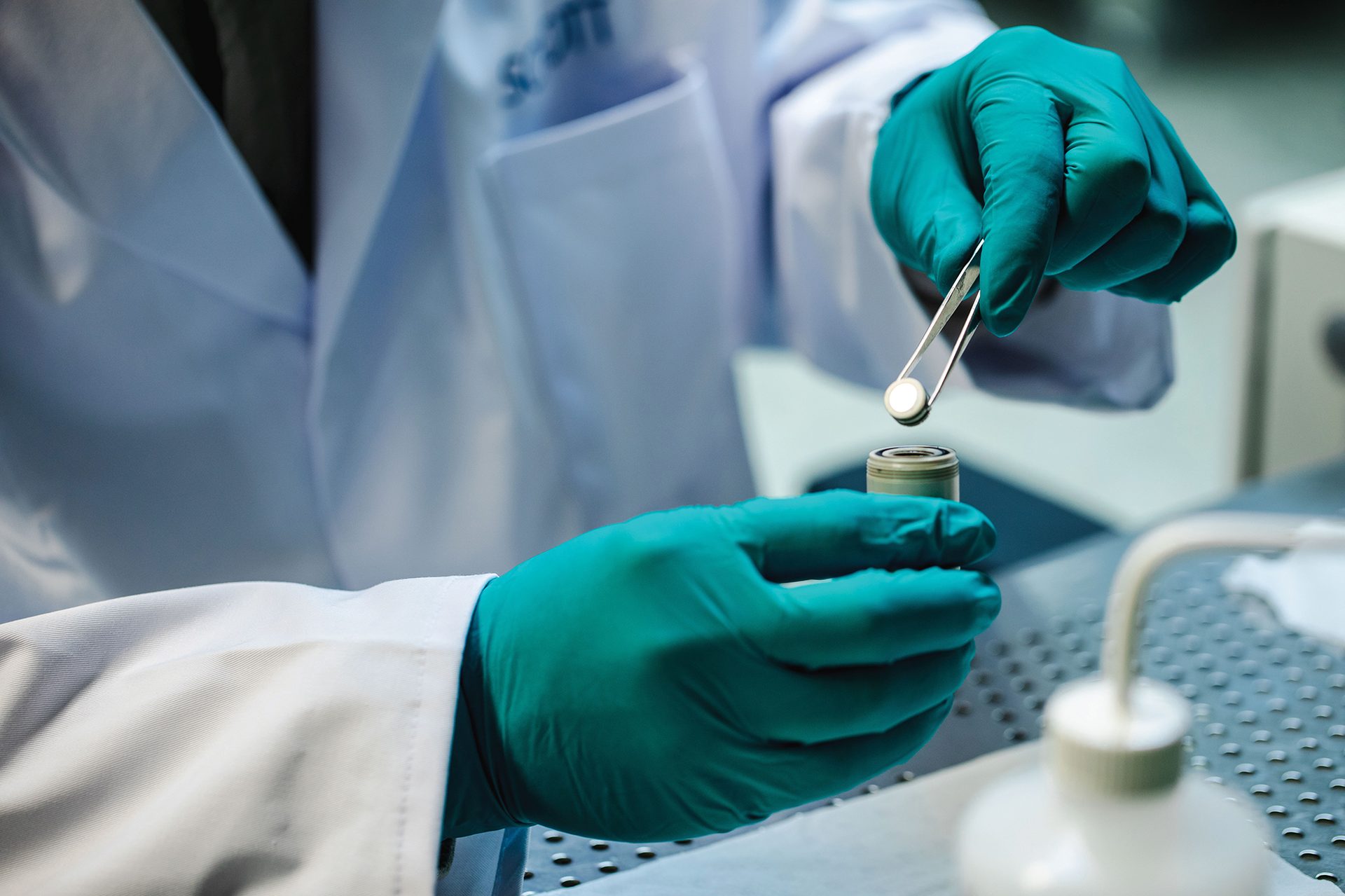
Germany: Building a climate for innovation
By Randy B. Hecht
bulletin | cover feature
In June 2023, the Fraunhofer Institute for Ceramic Technologies and Systems announced that its researchers had developed RECOSiC, an environmentally friendly recycling process that converts silicon carbide byproducts and waste back into high-quality silicon carbide.
Credit: Fraunhofer IKTS
Germany is confronting environmental and human capital challenges as it invests in R&D to support sustainable development goals.
As high temperature records were set and broken throughout the world during summer 2023, the climate crisis became the literal hot topic of the year.
But if Germany was stunned by the new normal in summer heat, the government was prepared to adjust its climate targets and programs.
The German Sustainable Development Strategy was introduced in 2002 and has been updated every four years since 2004. Built on “72 indicators and targets across 39 fields of action,” it provides a framework for monitoring improvements as well as “off-track indicators…for goals which will probably not be reached.”1
To underscore the connection between sustainable practice and economic development, the Federal Research Ministry’s “Research for Sustainability” program focuses on creating knowledge but “also aims to apply knowledge and become faster at translating research findings into practical application” in such fields as “green hydrogen, the circular economy, climate change mitigation and bioeconomy.” Its goal is to lead “the transformation of energy systems, resource efficiency, and climate protection.”2
ADVERTISEMENT
From academic to entrepreneurial
“Germany has a very strong culture of supporting and mentoring small- and medium-sized enterprises,” says ACerS president Sanjay Mathur, director and chair of the Institute of Inorganic Chemistry at the University of Cologne (Figure 1). “The country has very well-structured pathways to take R&D that is being done in academia or certain specialized institutions to the market.”
In most countries, Mathur notes, high technology ventures are analyzed initially in terms of barriers to entry. But the German approach is to start by considering whether those ventures can be drivers for collaboration between business and academia. The resulting research relationships “are formally structured in a way that you have enough degrees of freedom to operate,” he says, and afford Ph.D. students the opportunity to be funded by industry. His experience includes “regular and lively interaction” to ensure “absolute trust and transparency so that we can do something together.”
“Entrepreneurship is promoted in all possible ways,” Mathur says. There are stakeholder meetings. Technology scouts visit the labs and propose joint venture partners for promising projects. When university researchers attain a “great fundamental insight” but have no product, there are opportunities for knowledge transfer. “You can become a kind of consultant and be part of a big consortium,” Mathur says.
Given these market opportunities, Mathur prioritizes “inculcating an entrepreneurial mindset” in his students and faculty members. There are bench-to-business courses. There is the academic equivalent of cross-sectoral or interdepartmental collaboration, as when students of management and natural sciences draw on their combined expertise—a process that Mathur notes has produced start-up enterprises. His department has also engaged big corporations to teach dedicated courses on topics such as innovation management or technology transfer that are beyond the faculty members’ knowledge.
The platform for business development and technology commercialization is designed to support students’ ability to plan a venture, manage a start-up, and attract investors. This approach positions the university to serve as an incubator for fledgling businesses. Three of Mathur’s students pioneered a hybrid material for greener processing of photovoltaics and started a company that has done well and has received ongoing government support. An exchange student from India, after observing an electrospinning technique used to draw fibers from ceramics, started a company to market equipment that he engineered.
Universities have established intellectual property and patent policies to govern ownership of products and solutions that emerge from collaborative R&D. In some cases, the university retains ownership of intellectual property that results from its R&D activity. Other agreements structure shared ownership by the university and its industry partner or outline terms for a lump-sum payment to the university in return for ownership of intellectual property and patents.
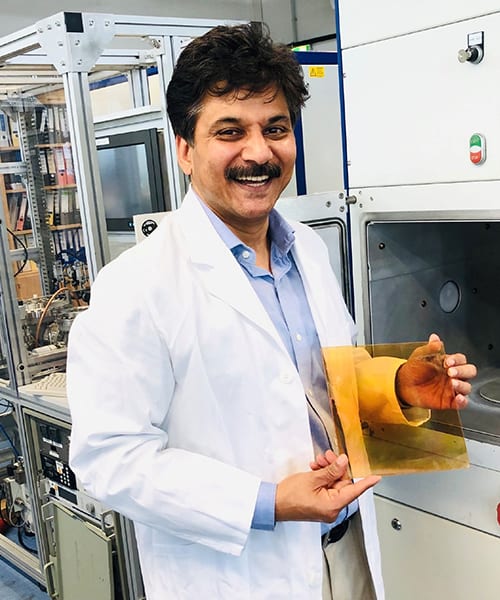
Figure 1. Sanjay Mathur in his lab at the University of Cologne. He says that Germany has “very well-structured pathways” to transition R&D conducted in academia or certain specialized institutions to the market.
Credit: Sanjay Mathur

Figure 1. Sanjay Mathur in his lab at the University of Cologne. He says that Germany has “very well-structured pathways” to transition R&D conducted in academia or certain specialized institutions to the market.
Credit: Sanjay Mathur
Sustainability and circularity
“Sustainable growth is part of the national strategy and also of institutional strength,” Mathur says. “How do we address the challenges of the energy sector, climate change, the circular economy, and futuristic mobility? It’s clear to the university leadership that these things must be part of the research portfolio.”
He sees decarbonization of ceramic processing and increased energy efficiency—for example, via low temperatures in ceramic sintering—as major drivers of the industry’s contributions to sustainable practice in industry.
“The National Sustainable Development Strategy is very, very ambitious, and it will require major transformation, not only in the research and development landscape, but in the way industry functions, the way the business is done. At the same time, we also need to involve the civilian society,” Mathur says. He sees the university’s role as producing “students who are global citizens” and joining in a national conversation about “how we make sustainability livable.”
Mathur notes that Germany shut down all its nuclear reactors, and renewables generate close to 45% of its energy today. Plus, the government is subsidizing the production of electric vehicles and photovoltaics.
There is a “huge market on small houses becoming energy self-sufficient by installments,” he says, and the country introduced a 49-euro train ticket that is good for travel nationwide, which has reduced the use of cars. The country is also exploring opportunities for applying the business model used in innovation-based engineering to other sectors, such as agriculture.
Mathur sees ceramics as contributing to the national sustainability priorities by playing a role in renewable energy technologies by advancing innovations in solid oxide fuel cells, solar cell panels, and batteries.
“If they are deployed heavily, they will reduce fossil fuels, support decarbonization, and support Germany’s goal to transition toward a carbon neutral society,” he says.
Mathur also monitors progress toward processing concrete that can be reused and integrating biopolymer fibers to create lightweight concrete. Plus, he is looking to additive manufacturing as a means of reducing materials usage.
“Ceramics will never go out of fashion,” he says. “R&D in the European and German ceramic industry is contributing significantly to sustainability. This is definitely something which we are part of, and also proud to be part of.”
Environment and enterprise
Businesses are finding parallels between the call to serve the common good and the need to operate profitably. SCHOTT AG is tracking market trends that align with opportunities to innovate in areas as diverse as energy, space, and medical technology.
Matthias Müller, executive vice president of R&D and new ventures, notes that advances in the development of electronic mobility and climate-neutral mobility depend on high-performing battery technology (Figure 2).
“We are intensively working on providing ion-conducting materials for the next generation of batteries, the all-solid-state batteries. Oxidic materials, of course, but also hybrid materials. There, glass can become an enabler,” he says (Figure 3).
Given the long timelines for all-solid-state battery development, demand for mature materials even at early stages presents a challenge to SCHOTT as a supplier. So, one imperative Müller sees is alignment across the value chain to adapt to the pace and scale of development.

Figure 2. Matthias Müller, executive vice president of R&D and new ventures at SCHOTT AG, says the company tracks market trends that align with opportunities to innovate in diverse sectors.
Credit: SCHOTT AG

Figure 2. Matthias Müller, executive vice president of R&D and new ventures at SCHOTT AG, says the company tracks market trends that align with opportunities to innovate in diverse sectors.
Credit: SCHOTT AG

Figure 3. SCHOTT is researching solid electrolytes and ion-conducting materials for use as cathodes in all-solid-state batteries.
Credit: SCHOTT AG
The company’s work on specialty glasses and high-tech materials that can withstand extreme environments in space proved to have new utility with the onset of COVID-19 vaccines that had to be transported frozen. SCHOTT launched the first product on the global market “capable of keeping closure integrity over the whole temperature range, which is required for mRNA,” Müller says.
In the field of medical technology, SCHOTT’s R&D extends, for example, to body implants and interfaces.
“Hermetic sealing of glass really exhibits quite a significant potential to have—even on a millimeter to micrometers scale—safe implants or interfaces, being inactive in the body later on,” Müller says. “This is a very interesting new field.”
Medical applications for specialty glasses range from vision correction to the use of light or radiation therapies.
Pursuing diversity and climate neutrality
There are also internal sustainability targets to pursue.
“We as an energy intensive industry, with gas melting and gas processing, have a particular responsibility,” Müller says.
He notes that the company’s objectives include being climate neutral by 2030, which he terms an intentionally ambitious goal, but also one that has been well received by customers and has increased employee motivation (Figure 4).
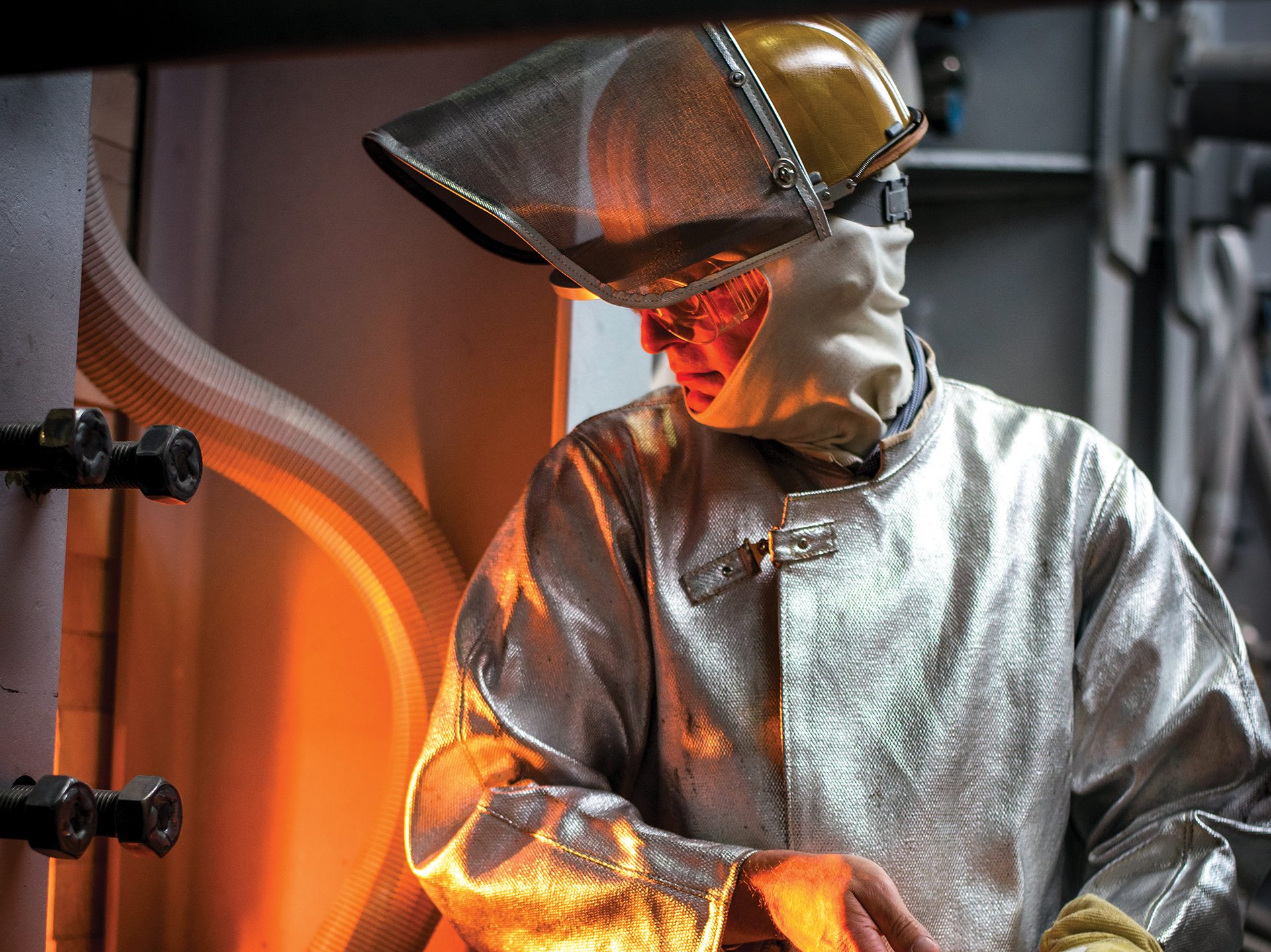
Figure 4. In July 2023, SCHOTT announced it had succeeded in producing a glass test melt with 100% hydrogen in the laboratory. The results confirmed that a change in melting technology away from using fossil fuels is possible.
Credit: SCHOTT AG
Circularity is one area of sustainable focus. It presents layers of challenges in the case of specialty glass integration into customers’ products and systems.
“Glass in general, but also the specialty glasses, are a material class that in most cases is highly environmentally friendly, because it does not easily dissolve and everything which is bonded into the glass is tightly bonded,” Müller says. “Compared to container glass or window glass, in the specialty glass area, recycling is a rather challenging topic, but we already started together with customers to work on that. And, of course, we have closed loops in our own operations.”
To meet its environmental, operating, and profitability targets, the company must strategize to ensure access to adequate human capital and has established a network within academia for access to Ph.D. and master’s candidates in Germany, throughout Europe, and globally.
“The area of glass manufacturing, and particularly glass science, is a rather small community,” Müller says. “But very often we also take advantage of general natural scientists—for example, from chemistry or physics—entering into our field.”
SCOTT also has a diversity and inclusion program that the R&D team strongly supports “because creativity, of course, takes a bit of great benefit from diversity. We want to gain the broadest possible perspectives we can include into our efforts in R&D,” Müller says.
A ceramic innovation institute
With an 80-million-euro annual budget, the Fraunhofer Institute for Ceramic Technologies and Systems is one of the world’s largest research institutions in ceramics. The scope of its work encompasses the entire ceramics universe under the activities of two major divisions: Structural Ceramics (automotive, medical, and machine engineering applications) and Functional Ceramics (electronic and electrochemical applications).
“Our biggest business segment right now is energy and environmental technology, including water treatment” says Institute director Alexander Michaelis. “This segment drives our research right now. Our mission is technology transfer, and we have one key performance indicator, which is how many projects and much revenue we get from industry.”
Among its biggest current revenue drivers are green hydrogen and battery technology, and one of its major areas of activity is in the field of lithium-ion batteries for mobility.
“But I think the bigger market is stationary applications, which are needed for successful energy transition,” Michaelis says. “You have to have electrochemical storage for short time peak shifts in applications, and here lithium-ion batteries are not a good solution due to safety issues and materials availability.”
Michaelis says they are looking into alternatives, with the most important alternative being high-temperature sodium chloride batteries. Fraunhofer IKTS has partnered on this project with companies in Australia and Germany, such as Altech, with the goal of producing at gigawatt scale for stationary applications.
“These kinds of systems are urgently needed for energy transition,” Michaelis says.
Another big need is storage for longer timeframes.
“Then you need other kinds of technologies, such as green hydrogen,” Michaelis says. “We also do a lot of development of high-temperature electrolysis systems, so-called solid oxide electrolysis, that are based on ceramic materials and have a 30% higher power to hydrogen conversion because waste heat can be used in the process.”
Among the advances they are developing is co-electrolysis capability, which enables conversion not only of water into hydrogen but also of carbon dioxide into carbon monoxide for generation of syngas. This syngas can be used for petrochemical production of all kinds of e-fuels.
SIDEBAR
ACerS International Germany Chapter
The Germany Chapter of The American Ceramic Society serves ACerS members in or near the cities of Cologne, Bonn, Aachen, Dusseldorf, and Dortmund for the purpose of promoting the arts and sciences connected with ceramics and glass science and engineering. Events such as workshops, industrial showcases, and seminars are planned to enhance and facilitate the interaction, technical discussions, and potential collaborations between ACerS members in Germany.
The Chapter is headquartered in Cologne, North-Rhine Westphalia. Interested ACerS members may contact any of the officers to learn more about getting involved with the Chapter.
- Chair: Ziyaad Aytuna
- Vice chair: Anna Kathrin Schmidt-Verma
- Secretary: Sumiya Iqbal
- Treasurer: Ruth Adam
- DEI representative: Kruti Halankar
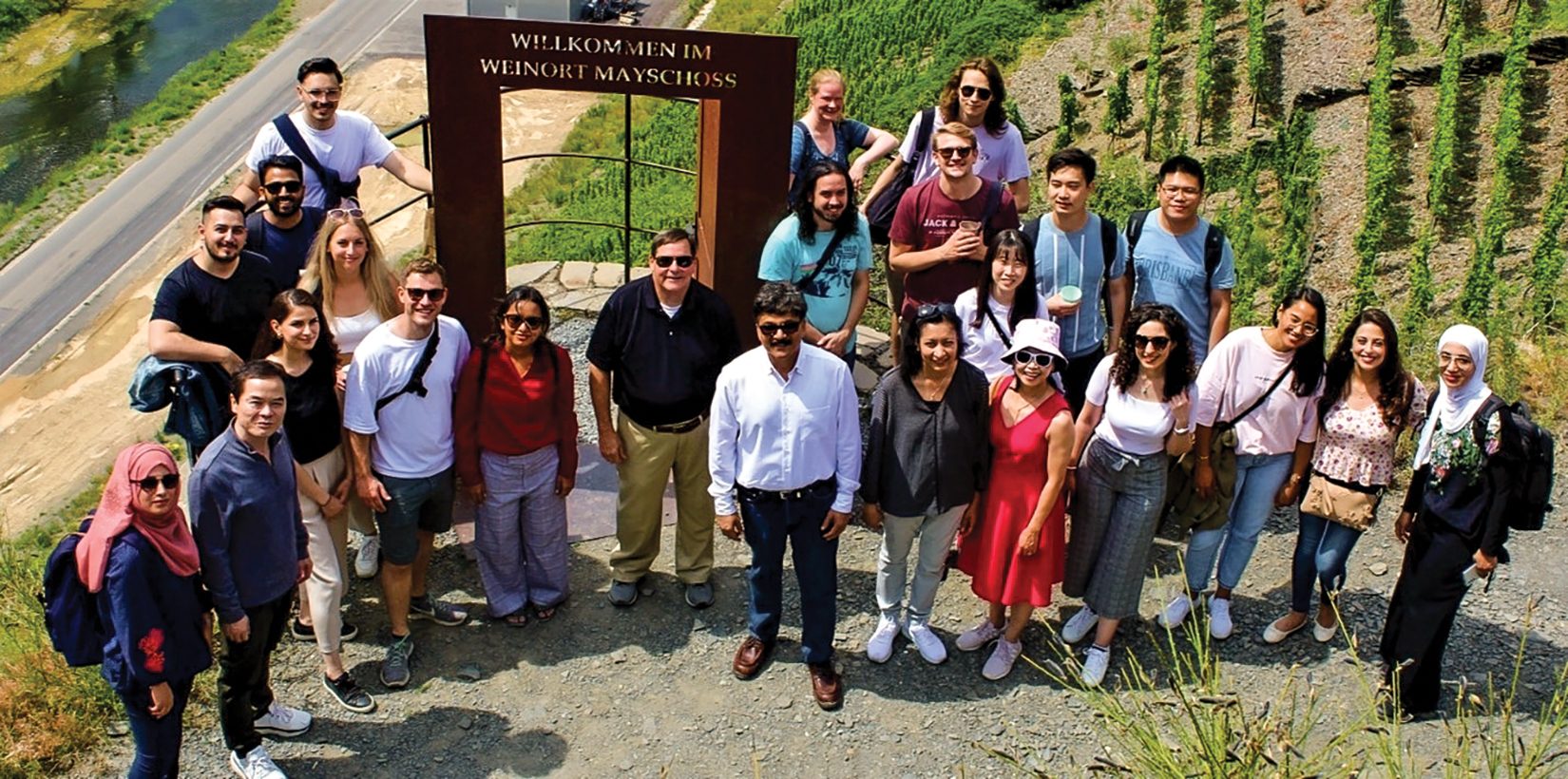
Besides providing opportunities to exchange science and engineering ideas, ACerS Germany Chapter organizes social outings to encourage networking and camaraderie among those working in the ceramic and glass industry. Here the Chapter enjoys a 2022 winery tour with ACerS executive director Mark Mecklenborg (blue shirt, center). Chapter chair and ACerS president Sanjay Mathur is pictured in the center (white shirt).
Credit: Sanjay Mathur
Attracting talent to work on ’mega topics’
The scope of Michaelis’s team’s work at the Fraunhofer Institute has created not only diversified business lines for generating profit but also organizational growth: there were 100 employees when Michaelis assumed his role as Institute director in 2004, and today he oversees a staff of 800.
“We were always able to get excellent people resources, and we still do. I think it’s very important that you work on the right subjects,” he says.
Instead of pitching the work as materials science, which he fears “sounds a little bit old-fashioned,” he tells candidates about the applications and solutions they will be helping to pioneer for energy-transition, closed cycle technologies, and water treatment—“all these mega topics.” He sees offering the opportunity to make a real contribution as the best way to attract young talent. Fraunhofer IKTS, which conducts business in English, also recruits international personnel, and he believes “there’s no limit to cross-border collaboration.”
The Institute’s initiatives are likewise designed for impact beyond Germany’s borders. The Institute is one of 25 partners in a European Union-funded project launched in summer 2023 in response to the regulatory requirement for European air traffic to be climate neutral by 2050. The project partners are collaborating on hydrogen and battery electric engines as well as wing optimization. The designs are projected to reduce fuel consumption by up to 15%.3
In July 2023, Fraunhofer IKTS announced that its researchers “have developed an extremely heat-resistant ceramic-based ink. For the first time, this enables metal components processed in the automotive industry at temperatures over 1,000°C to be marked with a code…The advantages of the technology are not simply the ability to detect production glitches and defective components at an early stage. It also opens up wide-ranging possibilities for designing process chains in the industry more efficiently and reducing their carbon footprint significantly.”4
And in June 2023, the Institute announced that its researchers had developed RECOSiC, “an especially environmentally friendly recycling process” that converts silicon carbide byproducts and waste “back into high-quality silicon carbide. This new process improves yields and also reduces the dependency on suppliers of raw materials.”5
Looking to the future, Michaelis sees continued demand for solutions that advance the world’s energy transition, especially those that achieve energy cost reductions—and in that respect, he sees ceramics as a field with an essential role to play in sustainable development.
An emerging climate for refractories
About midway between Bonn and Frankfurt lies Kannenbäckerland, where Europe’s largest clay deposits were discovered in the late 16th century. Many refractories continue to process those raw deposits in production facilities to this day. In 2022, German refractories generated 1.4 billion euros in sales and employed 6,500 people, most working in medium-sized companies.
Germany’s refractory sector “is one of the most important in the world and a leader in product solutions and manufacturing technologies,” says Thomas Kaczmarek, managing director of Deutsche Feuerfest Industrie e.V. (DFFI), the German Refractory Association. “The companies not only manufacture ceramic components and materials—they also organize a sustainable raw material economy, create jobs, and ensure all relevant training paths.”
DFFI, which will celebrate its 75th anniversary in 2024, is headquartered in an office that is also home to three other refractory organizations. Together, they form the European Refractory Center and collaborate with nearby institutes, training facilities, and universities that focus on ceramics. The Association advocates for its members’ shared economic and technical interests.
“It aims to be involved in important political decisions and in the development of legal frameworks,” Kaczmarek says, “and it participates in education and training, and science and research in the interests of the member companies at German and European level.”
Prominent enterprises within this refractory ecosystem include the Deutsches Institut für Feuerfest und Keramik, which Kaczmarek describes as “one of the world’s leading materials testing laboratories for refractory raw materials, products, and system solutions.” Equally notable is the Forschungsgemeinschaft Feuerfest e. V., which “carries out research and development projects, from basic research to publicly funded joint research between producers and users to individual cooperation in product or process technology” (Figure 5).
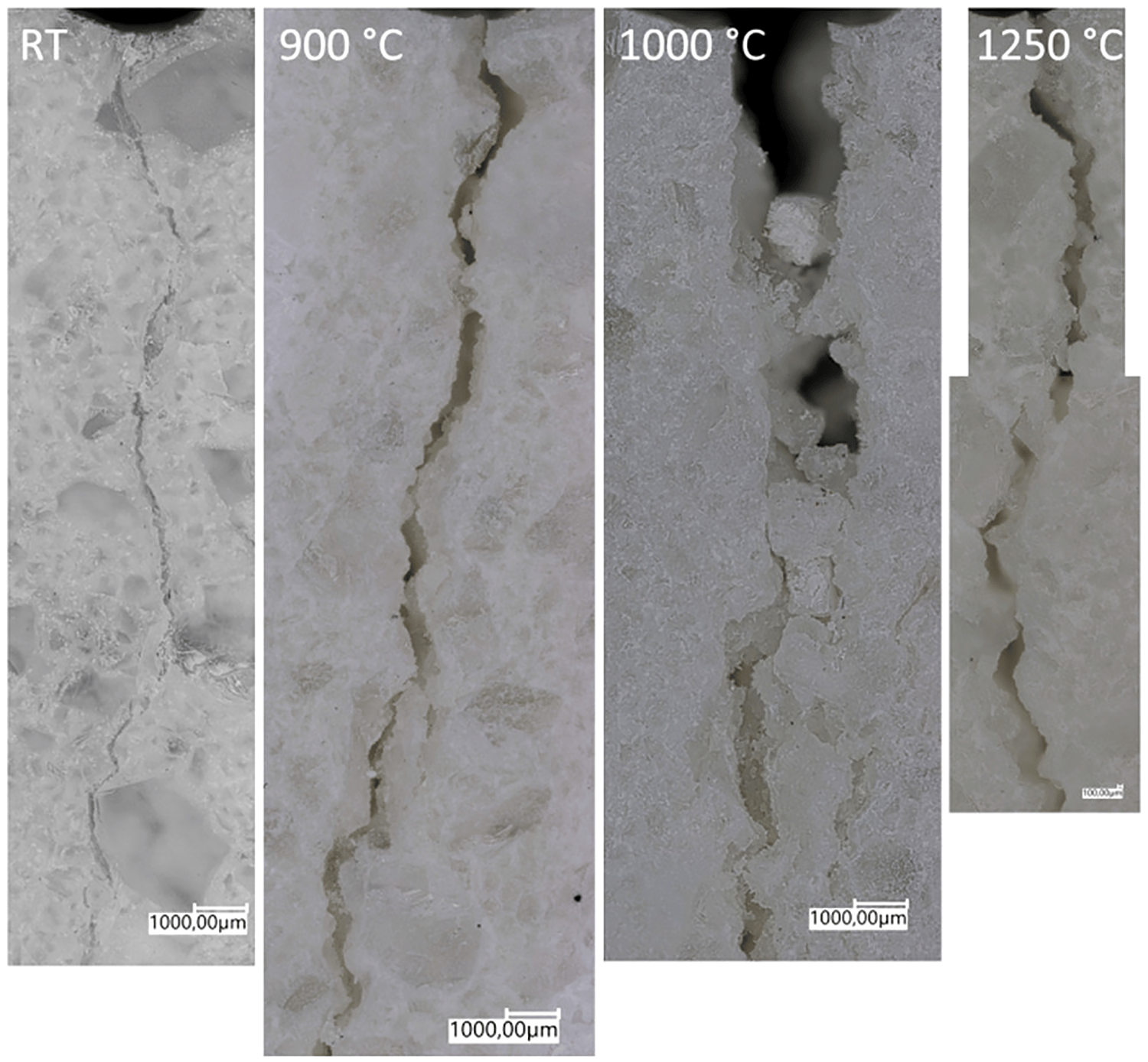
Figure 5. Example of research conducted at Forschungsgemeinschaft Feuerfest e. V. This image, which shows the crack path at different temperatures for fused silica bricks, is from a study on the fracture behavior of refractory materials up to service temperatures.
Credit: Brochen et al., International Journal of Ceramic Engineering & Science (CC BY 4.0)

Figure 5. Example of research conducted at Forschungsgemeinschaft Feuerfest e. V. This image, which shows the crack path at different temperatures for fused silica bricks, is from a study on the fracture behavior of refractory materials up to service temperatures.
Credit: Brochen et al., International Journal of Ceramic Engineering & Science (CC BY 4.0)
An emerging climate for refractories
About midway between Bonn and Frankfurt lies Kannenbäckerland, where Europe’s largest clay deposits were discovered in the late 16th century. Many refractories continue to process those raw deposits in production facilities to this day. In 2022, German refractories generated 1.4 billion euros in sales and employed 6,500 people, most working in medium-sized companies.
Germany’s refractory sector “is one of the most important in the world and a leader in product solutions and manufacturing technologies,” says Thomas Kaczmarek, managing director of Deutsche Feuerfest Industrie e.V. (DFFI), the German Refractory Association. “The companies not only manufacture ceramic components and materials—they also organize a sustainable raw material economy, create jobs, and ensure all relevant training paths.”
DFFI, which will celebrate its 75th anniversary in 2024, is headquartered in an office that is also home to three other refractory organizations. Together, they form the European Refractory Center and collaborate with nearby institutes, training facilities, and universities that focus on ceramics. The Association advocates for its members’ shared economic and technical interests.
“It aims to be involved in important political decisions and in the development of legal frameworks,” Kaczmarek says, “and it participates in education and training, and science and research in the interests of the member companies at German and European level.”
Prominent enterprises within this refractory ecosystem include the Deutsches Institut für Feuerfest und Keramik, which Kaczmarek describes as “one of the world’s leading materials testing laboratories for refractory raw materials, products, and system solutions.” Equally notable is the Forschungsgemeinschaft Feuerfest e. V., which “carries out research and development projects, from basic research to publicly funded joint research between producers and users to individual cooperation in product or process technology” (Figure 5).

Figure 5. Example of research conducted at Forschungsgemeinschaft Feuerfest e. V. This image, which shows the crack path at different temperatures for fused silica bricks, is from a study on the fracture behavior of refractory materials up to service temperatures.
Credit: Brochen et al., International Journal of Ceramic Engineering & Science (CC BY 4.0)

Figure 5. Example of research conducted at Forschungsgemeinschaft Feuerfest e. V. This image, which shows the crack path at different temperatures for fused silica bricks, is from a study on the fracture behavior of refractory materials up to service temperatures.
Credit: Brochen et al., International Journal of Ceramic Engineering & Science (CC BY 4.0)
Sharing knowledge, nurturing young talent
Knowledge-sharing is a priority among the member organizations, and the European Center for Refractories (ECREF) regularly hosts informational, networking, and educational or training events designed to strengthen the refractory sector in Germany.
For example, ECREF organizes the annual International Colloquium on Refractories, Europe's largest refractory event. The event, held in Aachen, combines a scientific conference; trade fair for refractory companies and suppliers of raw materials, machinery, and services; and networking and social events. The 66th colloquium takes place September 2024.
Additionally, ECREF’s range of seminars includes a recurring three-day event entitled "Refractories: Key technology and its applications," which is conducted in both German and English. The “Steel meets refractory” event provides a twice-yearly forum for technology experts from both sectors to discuss R&D and product development challenges.
The German Refractory Association hosted the International Technical Conference on Refractories (UNITECR) Sept. 26–29, 2023, in Frankfurt, where the theme, “The carbon challenge,” was designed to promote discussion of the transition from carbon to green hydrogen-based steel manufacture.
“The replacement of fossil fuels in high-temperature processes will have an impact on refractory materials,” Kaczmarek notes. “New technologies will require new lining concepts. Modified and new refractory lining concepts will also help to save energy and lower the carbon emissions for existing technologies and processes.”
In addition to the scientific conference program at UNITECR, which included 219 lectures, student contributions were recognized with the Gustav Eirich Award and a poster SLAM. A Women@Refractories networking event provided a forum for women in the industry to connect, and a similar reception for young professionals gave those entering the industry an opportunity to meet new friends and colleagues.
Post-graduate education and professional development are the focus of the organizations’ Integrated Refractory Education System, which provides vocational training and qualification at all levels from apprenticeship to doctorate. Kaczmarek explains: “The offer is even broader with the qualification as a state-certified ceramics technician or the academic education for a Bachelor of Engineering in the field of materials technology glass/ceramics at the Koblenz University of Applied Sciences. It is rounded off with a Master of Ceramic Science and Engineering degree.”
As it is across all sectors, sustainability is a priority in the German refractory industry.
“Refractories are made from natural materials. Their production is energy intensive and generates emissions,” Kaczmarek says. “At all levels of production, our industry is working together to reduce these emissions.”
He adds, “We are committed to continue down the decarbonization road, guided by the ambitions of the European Green Deal.”
The circular economy is another important aspect for the refractory industry as it aims to preserve limited resources and to reduce its own ecological footprint in addition to the footprint of its customer segments.
“Secondary raw materials from our industry are increasingly being reused. This reuse protects raw materials and limits the emissions associated with mining,” Kaczmarek says.
He adds, “We see ourselves as a system partner for our customers. The German companies don’t just deliver bricks; we see ourselves as system partners for our customers. Together we want to develop products and processes so that we can significantly reduce energy requirements overall in the future.”
SIDEBAR
Max Planck Gesellschaft: The research behemoth investigating everything
Visit the Max Planck Institute’s website, and the first thing you will learn is “There is no such thing as ‘the’ Max Planck Institute.” The name is shorthand for 85 institutes and research facilities (including five institutes and one research facility located outside Germany) whose workforce includes almost 20,900 employees, more than 2,500 guest scientists, and 519 scholarship holders.
Institutes focused on materials science research include
Max Planck Institute for the Structure and Dynamics of Matter (Hamburg)
“New methods are enabling physicists and biologists at the Max Planck Institute for the Structure and Dynamics of Matter to break new scientific ground. With the help of new radiation sources, especially the X-ray free-electron laser being built at the DESY in Hamburg, the researchers can show the properties and behavior of matter at a spatial resolution of a few nanometers and at time intervals of a few billionths of a billionth of a second. This provides them with completely new insights into the structure and function of biological materials and into the properties of solids and their electronic and structural dynamics. The coherent light of lasers enables the physicists to inspect the collective properties, for example, superconductivity, of complex solids, including many types of ceramics.”
Max Planck Institute for Polymer Research (Mainz)
“Scientists at the Max Planck Institute for Polymer Research…investigate polymers in all their different facets — their production, their physical properties, and their applications…Moreover, the researchers in Mainz are developing new procedures to spectrographically investigate polymers and to simulate their behavior on the computer. They also work with soft matter, which, like wine gums, combines the properties of solid bodies and liquids.”
Max Planck Institute for Solid State Research (Stuttgart)
“Lithium batteries that provide electric cars with power, superconductors that conduct electricity over long distances without loss, solar cells that harvest solar power…These are some of the phenomena which scientists investigate at the Max Planck Institute for Solid State Research. Solid state materials include metals, ceramics and even crystals of organic molecules. Just how the structures of these materials affect their electrical, mechanical and magnetic properties, is what solid-state researchers seek to under-stand. To this end, researchers particularly focus on solids at the nanoscale.”
Max Planck Institute of Colloids and Interfaces (Pottsdam-Golm)
“Tiny apatite crystals in bones, vesicles formed out of membranes, pores in membranes for fuel cells and microcapsules as vehicles for medical drugs—all these are structures that are larger than an atom, yet too small to be seen with the naked eye. These are the kinds of nanostructures and microstructures that scientists at the Max Planck Institute of Colloids and Interfaces examine and create.”
Max Planck Institute for Iron Research (Düsseldorf)
“Novel alloys for automotive lightweight design, materials for sustainable energy conversion and storage, and machine learning methods for material design—just a few examples of the research areas investigated at the Max-Planck-Institut für Eisenforschung. The researchers study complex materials down to the atomic scale while considering real environmental conditions.”
Max Planck Institute for Intelligent Systems (Tübingen, Stuttgart)
“Research expertise in the areas of computer science, material science and biology is brought together in one Institute, at two different sites. Machine learning, image recognition, robotics and biological systems will be investigated in Tübingen, while so-called learning material systems, micro- and nanorobotics, as well as self-organization will be explored in Stuttgart. Although the focus is on basic research, the Institute has a high potential for practical applications in, among other areas, robotics, medical technology, and innovative technologies based on new materials.”
Max Planck Institute of Microstructure Physics (Halle)
“The scientists at the Max Planck Institute for Microstructure Physics in Halle…investigate how the microstructure and nanostructure of metallic compounds affect their physical properties, for example how they behave as fiber optics or their magnetic characteristics. Their research concentrates on materials in low dimensions, for instance in a two-dimensional thin layer, a virtually one-dimensional nanowire or a minute heap of atoms, which physicists call a quantum dot and which, in some respects, resembles a single atom.”
Max Planck Institute for Chemical Physics of Solids (Dresden)
“The key research focus of the Institute is compounds of different metals. Chemists and physicists as well as experimental and theoretical scientists use state-of-the-art instruments and methods to investigate how the chemical composition, configuration of atoms and external forces affect the behavior of electrons. It is these that are responsible for the magnetic, electronic, and chemical properties of the compounds, and thus for their potential use as materials.”

